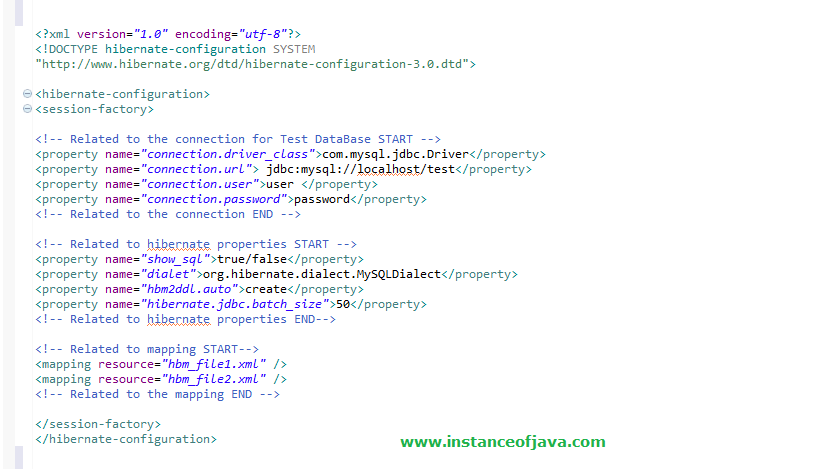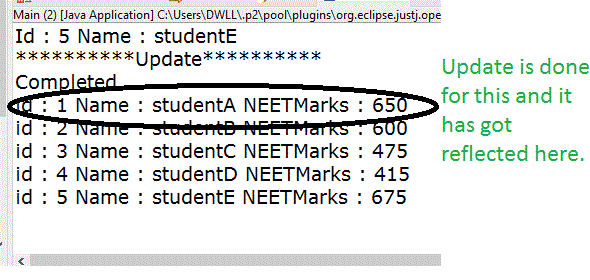
The query below was created when the application team used a non-indexed column as the predicate for the query. The table was too wide, and the application was querying it so many ways. I saw a table with 15 indexes because of this (not the worst I have seen, but not good). There is a habit of creating too many indexes when the business is screaming at the DBA to get the database up and running again because we are losing sales. The result is that the DBA now must react with an index after the damage is done.
#Hibernate java sql code#
Once the code was in production, it did not take very long for a small number of concurrent page loads to cause lock timeouts. Typical DBAs would think of such things, but Java developers will see that they invoked the user and product objects with a “where columnA =” and the result set was about 20 rows. This query was reading 32 million rows of data per page load. This caused a scan of the user table, AND the scan was executed 8 times per page load. Some code was checked in that used a non-indexed column as a predicate in the user table, along with a join to the product table. I worked at a company that had about 4 million rows in the users table. Adding nonindexed columns as your predicates can cause table scans, locking, blocking, and all kinds of nasty stuff. Developers may use predicates that are not indexed. It is easy to grab data from an object in any way that you want it. It seems that because an ORM obfuscates the database altogether developers almost forget that there is a database underneath the application. Here are some issues to be aware of: Scans Hibernate is not made to cover every scenario. For complicated queries, use inline SQL or stored procedures.It too is not intended for production use. Do not use built-in connection pooling.I will list a few, but my focus will be on actual scenarios that I have experience with. WHERE applicatio1_.user_identifier = doing a lot of reading online, you can find some good resources for Hibernate.

,applicatio1_.user_type_code AS user_ty65_8_0_įROM AppUser.application_user applicatio1_ ,applicatio1_.user_status_code AS user_st64_8_0_ ,applicatio1_.user_source_reference_identifier AS user_so63_8_0_ ,applicatio1_.security_question_identifier AS securit70_8_0_ ,applicatio1_.user_middle_name AS user_mi62_8_0_ ,applicatio1_.user_last_name AS user_la61_8_0_ ,applicatio1_.user_is_deleted_indicator AS user_is60_8_0_ ,applicatio1_.user_group_code AS user_gr69_8_0_ ,applicatio1_.user_first_name AS user_fi59_8_0_ ,applicatio1_.user_email_identifier AS user_em58_8_0_ ,applicatio1_.user_display_name AS user_di57_8_0_ ,applicatio1_.user_creation_type_code AS user_cr56_8_0_ ,applicatio1_.created_date AS created13_8_0_ ,applicatio1_.created_by AS created12_8_0_ ,applicatio1_.contact_phone_number AS contact11_8_0_ ,applicatio1_.communication_preference_code AS communi10_8_0_ ,applicatio1_.alternate_email_identifier AS alternat5_8_0_

SELECT applicatio1_.user_identifier AS user_ide1_8_0_ Hibernate will issue this query to the INT)

Query query = session.createQuery("from User where userID = :userID ") From within the application, the developer will write some code to get the user object for a userID. I have heard this as an argument in support of using an ORM, but I have rarely known companies to change the data technology, and keep the same old application code. It doesn’t care if you use Oracle, SQL Server, MySQL, or about a dozen other relational databases. In fact, Hibernate can even generate the data model directly from the Java object model layer. A Java developer can quickly develop data driven applications without worrying about the underlying data model. It obscures the data layer, and if you want, it will handle writing all the queries for you. It models relational data tables to Java classes, and Java data types to SQL data types. Hibernate is an Object Relational Mapping (ORM) solution for Java. My expertise is in SQL Server, but when Hibernate is interacting with your database, you will find yourself doing a LOT of reading online about the subject. I wanted to share some of my experiences working with SQL Server and Hibernate in a mixed Java/SQL Server environment. Query optimizers can be fickle things, and when not coded correctly, a query can easily consume every resource you have. But that speed is not realized without some language learning curve and a good understanding of internals. With relational databases, there is power in the tunability and speed of querying normalized relational data.


 0 kommentar(er)
0 kommentar(er)
